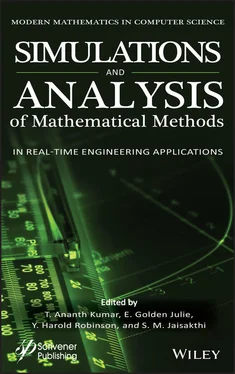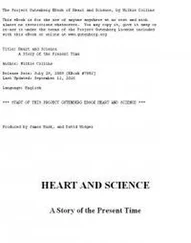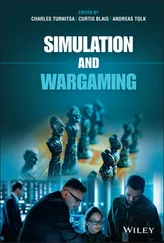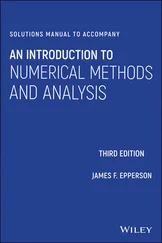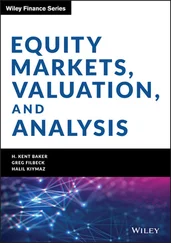A statistical and mathematical structure with some hidden layer configurations, the Markov chain model can be interpreted as the simple Basyian network that is directly visible to the Spectator Basyian network. For supervised and supervised simulations, this model makes a remarkable contribution. Education for strengthening and for pattern recognition, i.e. groups, if two instances are taken into account. A and B and it has 4 transitions when the system is in A, so it can be viewed similarly, as a transition from B when a system is in B, it can be viewed as a transition from A ( Figure 1.2). In this way, a transition matrix will be created that will define the probability of the transformation of the state. In this way, it states not only in two classes, but even without classes or classes, that the model can be created [3].
1.2.4 Method for Automated Simulation of Dynamical Systems
The problem of performing automated dynamic system simulation and how to solve this problem using AI techniques will be considered. Next, we’re going to consider some of the key ideas involved in the mathematical model simulation process. Then, as a software program, we can explore how these concepts can be applied.
a. Simulation of mathematical engineering models
If we consider a particular mathematical model, the problem of performing an effective simulation for a specific engineering system can be better understood. Let us consider the model below: X′ = σ(Y-X) Y′ = rX - Y - XZ (1.1)

Figure 1.2 Two state Markov model.
(1.1) 
where X, Y, Z, σ, r, b ∈ R, and σ, r and b are three parameters, which are usually taken to be optimistic, regardless of their physical origins. For different values of r in 0 < r < ∞, equations are also studied. Few researchers has studied this mathematical model to some degree, but there are still several questions to be answered regarding this model with regard to its very complicated dynamics for some ranges of parameter values [4].
For example, if we consider simulating eq. (1.1), the problem is choosing the appropriate parameter values for σ, r, b, so that the model’s interesting dynamic behaviour can be extracted. As we need to consider a three-dimensional search space σ r b and there are several possible dynamic behaviours for this model, the problem is not a simple one. In this case, the model is composed of three simultaneous differential equations, the behaviors can range from simple periodic orbits to very complicated chaotic attractors. Once the parameter values are selected then the problem becomes a numerical one, since then we need to iterate an appropriate map to approximate the solutions numerically.
b. Method for automated simulation using AI
Then determining the “best” set of parameter values BP for the mathematical model is the issue of performing automatic simulation for a specific engineering system. Here is where the technique of AI is really beneficial. In AI, the main concept is that we can use those techniques to simulate human experts in a specific application domain. In this case, we then use heuristics and statistical estimates derived from experts in this field to limit the computer program’s search space. You may define the algorithm for selecting the “best” set of parameter values as follows [9].
Step 1: Read the mathematical model M.
Step 2: Analyze the model M to “understand” its complexity.
Step 3: Generate a set of permissible AP parameters using the model’s initial “understanding.” This collection is generated by heuristics (expressed in the knowledge base as rules) and by solving some mathematical relationships that will later be described.
Step 4: Perform a selection of the “best” set of parameter values BP. This set is generated using heuristics (expressed as rules in the knowledge base).
Step 5: Execute the simulations by numerically solving the mathematical model equations. The various forms of complex behaviours are described at this stage.
A computer algorithm that can be called an intelligent device for simulating dynamical engineering systems is the result of this implementation [5].
1.2.5 kNN is a Case-Based Learning Method
For classification, it holds all the training details. In several applications, such as dynamic web mining for a wide repository, being a lazy learning technique prevents it. One way to enhance its effectiveness is to find some representatives to represent the entire classification training data, viz. Building an inductive learning model from the dataset of training and using this model for classification (representatives). There are several existing algorithms initially built to construct such a model, such as decision trees or neural networks. Their efficiency is one of the assessment benchmarks for various algorithms. Since kNN is a simple but effective classification method and is convincing as one of the most effective methods in text categorization for Reuters corpus of newswire articles, it motivates us to create a model for kNN to boost its efficiency while also maintaining its accuracy of classification [9]. Figure 1.3shows frequency distribution in statistics is a representation that displays the number of observations within a given interval.
B. Support Vector Machine (SVM)
Support vector machines [7] (SVMs, also support vector networks) analyse knowledge used for classification and regression analysis in machine learning. An SVM training algorithm generates a model that assigns new examples to one category or another, given a set of training examples, each marked as belonging to one or the other of two categories. The picture below has two data forms, red and blue. In kNN, we used the test data to measure its distance to all training samples and to take the minimum distance sample. It takes a lot of time to calculate all the distances and a lot of memory to store all the samples from the training.

Figure 1.3 Distribution of data points and first obtained representative.
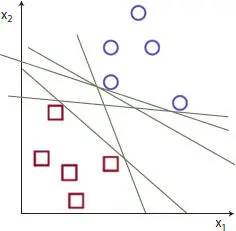
Figure 1.4 SVM.
Our primary objective is to find a line that divides the data uniquely into two regions. Such knowledge that can be split into two with a straight line (or high dimension hyperplanes) is called Linear Separable.
In the above Figure 1.4, intuitively, the line should pass as far as possible from all the points as there can be noise in the incoming data. The accuracy of the classification does not affect this data. Thus, the farthest line would offer more immunity against noise. Therefore, SVM discovers a straight line (or hyperplane) with the highest minimum distance from the training samples [10].
1.2.6 Comparison for KNN and SVM
KNN classifies knowledge based on the distance metric, while SVM needs a proper training process. Because of the optimal design of the SVM, it is guaranteed that the separated data will be separated optimally. KNN is commonly used as multi-class classifiers, while regular binary data belonging to either one class is different from SVM. A One-vs-One and One-vs-All strategy is used for a multiclass SVM. Figure 1.5explains about hyperplanes are decision boundaries that help classify the data points. Data points falling on either side of the hyperplane can be attributed to different classes. Also, the dimension of the hyperplane depends upon the number of features. In the One-vs-one method, n *(n-1)/2 SVMs must be trained: one SVM for each pair of classes. Among all outcomes of all SVMs, we feed the unknown pattern to the entity and the final decision on the form of data is determined by majority result. This method is often used in the classification of multiple groups. We have to train as many SVMs when it comes to the One-vs-All approach as there are groups of unlabeled data. As in the other method, if given to the SVM with the greatest decision value, we give the unidentified pattern to the system and the final result.
Читать дальше
